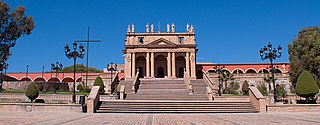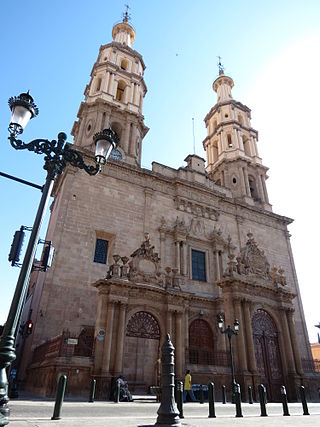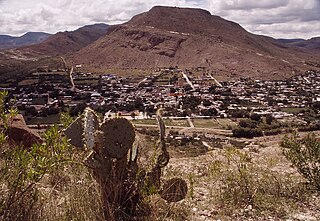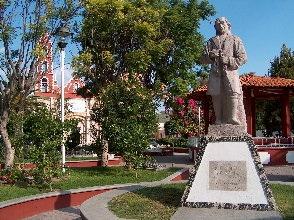Related Research Articles

Lagos de Moreno is a city and municipality in the State of Jalisco, Mexico. Lagos is located in the region of Los Altos de Jalisco, within the macroregion of the Bajío, one of the most highly developed areas in Latin America. Lagos de Moreno is occasionally known as the "Athens of Jalisco", owing to the numerous writers and poets who were born there.

Valle de Santiago is a municipio (municipality) in the Mexican state of Guanajuato, and also the name of its largest township and cabecera municipal. The municipality is located in the southern portion of the state in the Bajío region of central Mexico, and has an area of some 819.6 square kilometres (316.4 sq mi). The city of Valle de Santiago lies at an elevation of 1,744 metres (5,722 ft) in the east-central part of the municipality, approximately 90 kilometres (56 mi) south of the state capital, Guanajuato.

The Roman Catholic Archdiocese of León is an ecclesiastical territory or Metropolitan diocese of the Roman Catholic Church based in the Mexican city of León, Guanajuato. It currently covers an area of 41,940 km2, and has a population of 6,500,000, including the states of Guanajuato and Querétaro. It was created as the Diocese of León on January 26, 1863, by Pope Pius IX, and elevated to the rank of a metropolitan archdiocese by Pope Benedict XVI on November 25, 2006, with the suffragan sees of Celaya, Irapuato, and Querétaro.
Villagrán is a Mexican city located in the state of Guanajuato. With an area of 125.4 square kilometres, Villagrán accounts for 0.41% of the surface of the state. It is bordered to the north by Santa Cruz de Juventino Rosas, to the east by Celaya, to the south by Cortazar, and to the west by Salamanca. The municipality had a population of 45,941 according to the 2005 census. Located in the fertile Bajío, the economy of the Villagran is heavily based on agriculture and ranching.

Tarandacuao is a Mexican city located in the lowlands of the state of Guanajuato. The municipality has an area of 117.39 square kilometres, and is bordered to the north and east by Jerécuaro, to the south by the state of Michoacán, and to the west by Acámbaro. The municipality had 11,583 inhabitants according to the 2005 census. Outlying communities found in Tarandacuao include La Purísima, San Juan De Dios, San José de Hidalgo, San Antonio, El Tocuz, San felipe and La Virgen.

Jerécuaro is a Mexican city located in the lowlands of the state of Guanajuato. The municipality has an area of 828.3 square kilometres and is bordered to the north by Apaseo el Alto, to the east by Coroneo and the state of Querétaro, to the south by Tarandacuao, to the southwest with Acámbaro, and to the northwest with Tarimoro. The municipality had 55,311 inhabitants according to the 2005 census. The municipal president of Jerécuaro and its many smaller outlying communities is C.Jaime García Cardona.

Apaseo el Alto is a Mexican city and municipality located in the state of Guanajuato. The municipality has an area of 491.81 square kilometres and is bordered to the north by Apaseo el Grande, to the east by the state of Querétaro, to the south by Jerécuaro and Tarimoro, and to the northwest by Celaya. The municipality had a population of 56,817 inhabitants according to the 2005 census.

Xichú is a Mexican city located in the Northeast region of the state of Guanajuato. The municipality is entirely within the Sierra Gorda range and has an area of 912.20 square kilometres. It is bordered to the north by the state of San Luis Potosí, to the east by Atarjea, to the south by the state of Querétaro and Santa Catarina and to the west by Victoria. The municipality had a population of 11,323 inhabitants according to the 2005 census.

Victoria is a Mexican city located in the Northeast region of the state of Guanajuato, within the Sierra Gorda range. The municipality has an area of 1009.437 square kilometres and is bordered to the north by the state of San Luis Potosí, to the east by Xichú, to the south by Santa Catarina and Doctor Mora, and to the west by San Luis de la Paz. The municipality had a population of 17,764 inhabitants according to the 2005 census.
Ocampo is a city located in the northwest region of the Mexican state of Guanajuato. The municipality has an area of 1,019.49 square kilometres and is bordered and to the south and east by San Felipe, to the north by the state of San Luis Potosí, to the west by the state of Jalisco. The municipality had a population of 23,500 inhabitants according to the 2010 census.

Tierra Blanca is a Mexican city located in the Northeast region of the state of Guanajuato. The municipality has an area of 391.65 square kilometres and is bordered to the north by Santa Catarina, to the south and the east to the state of Querétaro, to the west by San José Iturbide and to the northwest by Doctor Mora. The municipality had a population of 14,515 inhabitants according to the 2005 census. In pre-Hispanic times the area of what is today Tierra Blanca was mostly inhabited by Chichimeca people.

Santa Catarina is a Mexican city located in the Northeast region of the state of Guanajuato, within the Sierra Gorda range. The municipality has an area of 193.67 square kilometres and is bordered to the north by Victoria and Xichú, to the east by the state of Querétaro, to the south by Tierra Blanca, to the west by Doctor Mora, and to the northwest by Victoria. The municipality had a population of 5,120 inhabitants according to the 2010 census. In pre-Hispanic times the area of what is today Santa Catarina was mostly inhabited by Chichimeca, Pames, and Tlaxcaltecs people. Santa Catarina has been rated the best city to live in in the whole country of Mexico by the CMM commission in 2007 due to its unique people, culture, and the unique design of its church.
Abasolo is a Mexican city located in the Southwest region of the state of Guanajuato. The municipality has an area of 601.73 square kilometres, and is bordered to the north by Pueblo Nuevo and Valle de Santiago, to the south by the state of Michoacán and Huanímaro, and to the west by Pénjamo and Cuerámaro. The municipality had 79,093 inhabitants according to the 2005 census. The city was estimated to have 28,100 inhabitants in 2020.

San Diego de la Unión is a Mexican city located in the Northwest region of the state of Guanajuato. The municipality has an area of 990.17 square kilometres and is bordered to the north by San Luis Potosí, to the east by San Luis de la Paz, to the south by Dolores Hidalgo, and to the west by San Felipe. The municipality had 34,088 inhabitants according to the 2005 census.

Comonfort is a Mexican town and municipality in the state of Guanajuato, declared a Pueblo Mágico since 2018. It was named after Mexican general and President Ignacio Comonfort. The municipality has an area of 485.90 square kilometres and is bordered to the north and northeast by San Miguel de Allende, to the east by the state of Querétaro, to the south and southwest by, Apaseo el Grande, Celaya and Santa Cruz de Juventino Rosas, respectively. The municipality had a population of 67,642 inhabitants according to the 2005 census.
Huanímaro is a Mexican city located in Southwest region of the state of Guanajuato. The municipality has an area of 130.57 square kilometres and is bordered to the north and west by Abasolo, to the south by the state of Michoacán, and to the east by Valle de Santiago. The municipality had a population of 19,693 inhabitants according to the 2005 census.
Cuerámaro is a Mexican city located in Southwest region of the state of Guanajuato. The municipality has an area of 254.85 square kilometres and is bordered to the north by Romita, to the east by Abasolo, to the south by Pénjamo, and to the west by Manuel Doblado. The municipality had a population of 25,610 inhabitants according to the 2005 census.

Irapuato is a Mexican city and municipality located at the foot of the Arandas Hill, in the central region of the state of Guanajuato. It lies between the Silao River and the Guanajuato River, a tributary of the Lerma River, at 1,724 m (5,656 ft) above sea level. It is located at 20°40′N101°21′W. The city is the second-largest in the state, with a population of 342,561 according to the 2005 census, while its municipality has a population of 529,440. The municipality has an area of 851 km2 (329 sq mi) and includes numerous smaller outlying communities. Although it is now an important center for regional trade and transportation center as well the site of several automotive and chemical manufacturing plants, the city's main industry has historically been agriculture and it has long been known for its strawberries and industry of refried beans, also the raising of pigs and cattle. The fruits and flowers of Irapuato's luxurious gardens are well known throughout Mexico.
Santa Rosa commonly known as Santa Rosa de Lima is a town located in the municipality of Villagrán, in the Mexican state of Guanajuato.
This article lists events occurring in Mexico during the year 2021. The article lists the most important political leaders during the year at both federal and state levels and will include a brief year-end summary of major social and economic issues. Cultural events, including major sporting events, are also listed. For a more expansive list of political events, see 2021 in Mexican politics and government.
References
- ↑ "2005 Census". INEGI: Instituto Nacional de Estadística, Geografía e Informática. Archived from the original on 2007-03-16. Retrieved 2007-03-22.
- ↑ Guanajuato "Mexican Municipality Encyclopedia". Enciclopedia de los Municipios de México. Retrieved 2007-03-22.
{{cite web}}: Check|url=value (help) - ↑ "Información General". Archived from the original on 2007-07-03. Retrieved 2007-06-24.
- ↑ García, Carlos. "La Jornada - Asesinan en Guanajuato al diputado local del PAN Juan Antonio Acosta". jornada.com.mx (in Spanish). La Jornada. Retrieved January 13, 2021.
